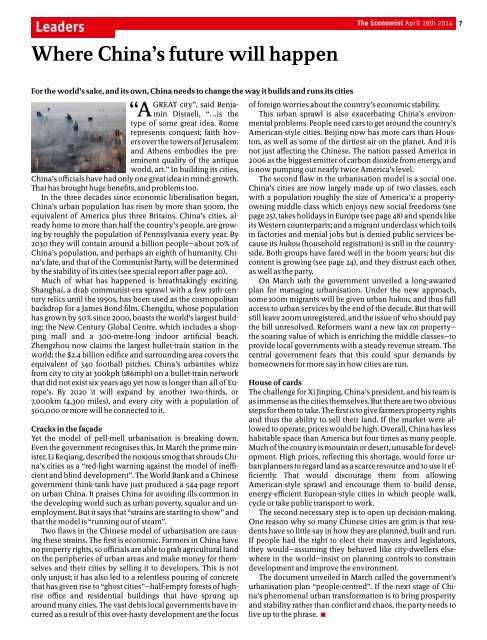The Economist - 19_25 April 2014
The Economist - 19_25 April 2014
The Economist - 19_25 April 2014
- No tags were found...
You also want an ePaper? Increase the reach of your titles
YUMPU automatically turns print PDFs into web optimized ePapers that Google loves.
LeadersWhere China’s future will happen<strong>The</strong> <strong>Economist</strong> <strong>April</strong> <strong>19</strong>th <strong>2014</strong> 7Forthe world’s sake, and its own, China needs to change the way it builds and runs its citiesGREAT city”, said BenjaminDisraeli, “…is the“Atype of some great idea. Romerepresents conquest; faith hoversoverthe towers ofJerusalem;and Athens embodies the preeminentquality of the antiqueworld, art.” In building its cities,China’s officials have had only one great idea in mind: growth.That has brought huge benefits, and problems too.In the three decades since economic liberalisation began,China’s urban population has risen by more than 500m, theequivalent of America plus three Britains. China’s cities, alreadyhome to more than half the country’s people, are growingby roughly the population of Pennsylvania every year. By2030 they will contain around a billion people—about 70% ofChina’s population, and perhaps an eighth of humanity. China’sfate, and that of the Communist Party, will be determinedby the stability ofits cities (see special report after page 40).Much of what has happened is breathtakingly exciting.Shanghai, a drab communist-era sprawl with a few <strong>19</strong>th-centuryrelics until the <strong>19</strong>90s, has been used as the cosmopolitanbackdrop for a James Bond film. Chengdu, whose populationhas grown by 50% since 2000, boasts the world’s largest building:the New Century Global Centre, which includes a shoppingmall and a 300-metre-long indoor artificial beach.Zhengzhou now claims the largest bullet-train station in theworld: the $2.4 billion edifice and surrounding area covers theequivalent of 340 football pitches. China’s urbanites whizzfrom city to city at 300kph (186mph) on a bullet-train networkthat did not exist six years ago yet now is longer than all of Europe’s.By 2020 it will expand by another two-thirds, or7,000km (4,300 miles), and every city with a population of500,000 or more will be connected to it.Cracks in the façadeYet the model of pell-mell urbanisation is breaking down.Even the government recognises this. In March the prime minister,Li Keqiang, described the noxious smog that shrouds China’scities as a “red-light warning against the model of inefficientand blind development”. <strong>The</strong> World Bank and a Chinesegovernment think-tank have just produced a 544-page reporton urban China. It praises China for avoiding ills common inthe developing world such as urban poverty, squalor and unemployment.But it says that “strains are starting to show” andthat the model is “running out ofsteam”.Two flaws in the Chinese model of urbanisation are causingthese strains. <strong>The</strong> first is economic. Farmers in China haveno property rights, so officials are able to grab agricultural landon the peripheries of urban areas and make money for themselvesand their cities by selling it to developers. This is notonly unjust; it has also led to a relentless pouring of concretethat has given rise to “ghost cities”—half-empty forests of highriseoffice and residential buildings that have sprung uparound many cities. <strong>The</strong> vast debts local governments have incurredas a result of this over-hasty development are the focusofforeign worries about the country’s economic stability.This urban sprawl is also exacerbating China’s environmentalproblems. People need cars to get around the country’sAmerican-style cities. Beijing now has more cars than Houston,as well as some of the dirtiest air on the planet. And it isnot just affecting the Chinese. <strong>The</strong> nation passed America in2006 as the biggest emitter ofcarbon dioxide from energy, andis now pumping out nearly twice America’s level.<strong>The</strong> second flaw in the urbanisation model is a social one.China’s cities are now largely made up of two classes, eachwith a population roughly the size of America’s: a propertyowningmiddle class which enjoys new social freedoms (seepage <strong>25</strong>), takes holidays in Europe (see page 48) and spends likeits Western counterparts; and a migrant underclass which toilsin factories and menial jobs but is denied public services becauseits hukou (household registration) is still in the countryside.Both groups have fared well in the boom years; but discontentis growing (see page 24), and they distrust each other,as well as the party.On March 16th the government unveiled a long-awaitedplan for managing urbanisation. Under the new approach,some 100m migrants will be given urban hukou, and thus fullaccess to urban services by the end of the decade. But that willstill leave 200m unregistered, and the issue ofwho should paythe bill unresolved. Reformers want a new tax on property—the soaring value of which is enriching the middle classes—toprovide local governments with a steady revenue stream. <strong>The</strong>central government fears that this could spur demands byhomeowners for more say in how cities are run.House of cards<strong>The</strong> challenge for Xi Jinping, China’s president, and his team isas immense as the cities themselves. But there are two obviousstepsforthem to take. <strong>The</strong> firstisto give farmersproperty rightsand thus the ability to sell their land. If the market were allowedto operate, prices would be high. Overall, China has lesshabitable space than America but four times as many people.Much ofthe country is mountain ordesert, unusable for development.High prices, reflecting this shortage, would force urbanplanners to regard land as a scarce resource and to use it efficiently.That would discourage them from allowingAmerican-style sprawl and encourage them to build dense,energy-efficient European-style cities in which people walk,cycle or take public transport to work.<strong>The</strong> second necessary step is to open up decision-making.One reason why so many Chinese cities are grim is that residentshave so little say in how they are planned, built and run.If people had the right to elect their mayors and legislators,they would—assuming they behaved like city-dwellers elsewherein the world—insist on planning controls to constraindevelopment and improve the environment.<strong>The</strong> document unveiled in March called the government’surbanisation plan “people-centred”. If the next stage of China’sphenomenal urban transformation is to bring prosperityand stability rather than conflict and chaos, the party needs tolive up to the phrase. 7


